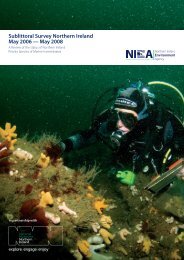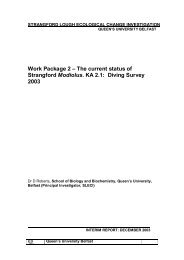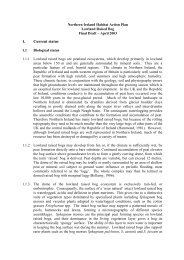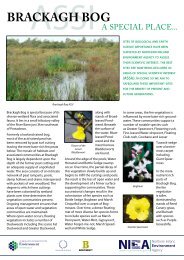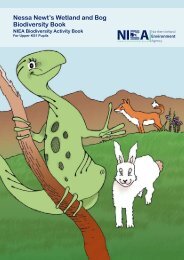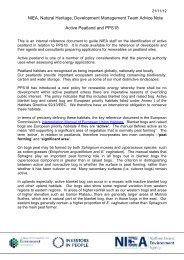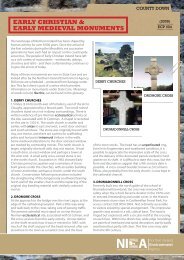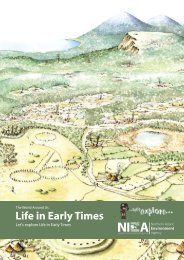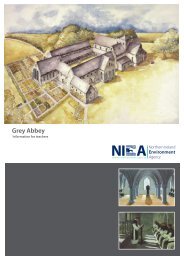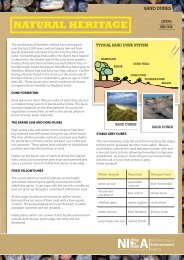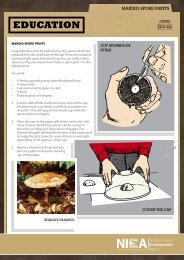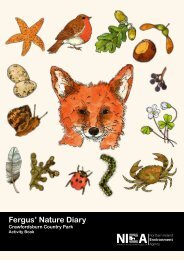Binevenagh Nature Reserve Information for Teachers (.PDF 0.97
Binevenagh Nature Reserve Information for Teachers (.PDF 0.97
Binevenagh Nature Reserve Information for Teachers (.PDF 0.97
Create successful ePaper yourself
Turn your PDF publications into a flip-book with our unique Google optimized e-Paper software.
www.ni-environment.gov.uk<br />
History<br />
We can find out about the past in a number of ways.<br />
One method is to examine the place names. The major<br />
monument on the reserve itself is known as a defensive<br />
earthwork, although very little of the structure remains.<br />
It appears as a vague shape in the ground. Its origin is<br />
obscure but it probably originated during the Iron Age<br />
be<strong>for</strong>e the time of Christ. It rejoices in two names. The first<br />
is ‘Craigbolie Castle’, which refers to its use as a compound<br />
<strong>for</strong> cattle. Be<strong>for</strong>e 1600 it was the custom <strong>for</strong> people to<br />
drive their cattle into the hills <strong>for</strong> grazing. They would<br />
remain there <strong>for</strong> the summer in temporary dwellings<br />
returning to lower ground <strong>for</strong> the winter. This process was<br />
known as bolleying. ‘Craigbolie’ means the ‘rock of the<br />
bolleying’. The alternative name is ‘Dun Crutheni’. In Irish<br />
the word ‘dun’ means <strong>for</strong>t.’ Cruithin’ is a very old name and<br />
its meaning has changed through time. It originally meant<br />
the people who lived in what is now Britain. It was also<br />
used to mean the Picts, the people who lived in Scotland.<br />
It could also mean the strangers. Whatever its meaning<br />
it must have once belonged to people who came into<br />
the area at some time in the past. The name <strong>Binevenagh</strong><br />
means the ‘The peak of Foibhne’. Foibhne was a pre-<br />
Christian chief said to have been slain nearby.<br />
We can also find out about the past through stories<br />
handed down through time. Some of these stories are<br />
based on legends. The Ordnance Survey map shows a<br />
feature called ‘Finn Mc Cool’s Finger Stone’. This large<br />
stone is thought to be part of a dolman. A dolman is a<br />
Bronze Age monument made up of a large cap stone held<br />
up by three or more supporting stones. Finn Mc Cool was<br />
the legendary Irish giant who supposedly built the Giant’s<br />
Causeway. Towards the eastern end of the <strong>Binevenagh</strong><br />
cliffs is a cave high up on the rock face. Local folklore has<br />
it that this was the hiding place of ‘Paddy Cushy Glen’.<br />
Unlike Finn Mc Cool, he was a real person. He was a<br />
famous outlaw of which there were many in Ireland in the<br />
18th century, known as Tories, (from the Irish toraigh - to<br />
pursue) or Rapparees, (from the Irish rápaire - a long knife<br />
or pike). Such people may have been outlaws as far as<br />
the authorities were concerned but might not have been<br />
regarded as such by the local people. Cushy Glen would<br />
have had very little support from local people, however,<br />
as he was a thief and a murderer. He was killed during a<br />
robbery in 1804. His brother James was said to be hanged<br />
<strong>for</strong> stealing three cows.<br />
Old buildings also tell us a great deal about people’s<br />
lives in the past. Hidden in the <strong>for</strong>est just below the<br />
reserve are ruined stone cabins. They are typical of such<br />
<strong>Binevenagh</strong> <strong>Nature</strong> <strong>Reserve</strong><br />
dwellings from all over Ireland. Many such houses were<br />
occupied be<strong>for</strong>e the great famine of 1847. People at that<br />
time lived on high ground in larger numbers than today.<br />
They were able to grow potatoes, which kept them alive<br />
if very poor. The tragedy of the potato famine <strong>for</strong>ced them<br />
away from their homes. Many of these houses were still<br />
occupied until recent times, when people were prepared<br />
to tolerate the rigours of a mountain existence better<br />
than we would today. They were gradually abandoned<br />
as people sought a more com<strong>for</strong>table life on the lower<br />
ground. The land where they once lived is now used <strong>for</strong><br />
<strong>for</strong>estry plantations. The trees have simply been planted<br />
around their old homes.<br />
Site of Craigbolie Castle<br />
Cushy Glen’s Cave<br />
Ruined House<br />
8




